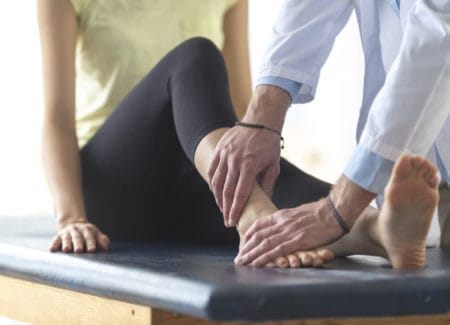
Medically reviewed by Misty Seidenburg
Whether you’re an athlete, on your feet all day for work, or simply enjoy staying active, aching tendons in your foot can interfere with your lifestyle. Conditions like Achilles tendinopathy, plantar fasciitis, and posterior tibial tendon dysfunction are common culprits, but with early attention and the proper care, symptoms can improve significantly. Keep reading to learn about physical therapy for foot tendinopathy, when to seek help, and how treatment can restore pain-free movement.
Foot tendinopathy is a condition involving irritation, degeneration, or injury to one or more of the tendons in the foot. Tendons are tough, fibrous bands of connective tissue that play a crucial role in the body by attaching muscles to bones, allowing for smooth and coordinated movement.
If tendons become overused, strained, or damaged, you can experience pain, swelling, and stiffness in the affected area. In the feet, symptoms are often most noticeable during physical activity or after rest, making everyday movements like walking, running, or standing more difficult and uncomfortable.
You may have heard the terms tendinosis, tendinitis, and tendinopathy used interchangeably, but their differences are worth noting.
| Condition | Reactive Tendinopathy (Tendinitis Common Term) | Dysrepair | Degenerative (Tendinosis Common Term) |
|---|---|---|---|
| Age Range | Younger (15-25 years) | Older adult (40-60 years) | Older (30-60 years) or chronic overload in young elite athletes |
| Onset | Rapid onset, generally related to burst of unaccustomed activity | Onset after overload | Long history of minimal symptoms |
| Aggravating Factors | Easily aggravated by exercise, slow to settle | Past history with load-related exacerbations | Unloading strategies or atrophy |
| Swelling | N/A | Variable swelling | Variable swelling and lumps/bumps |
| Irritability | N/A | Less irritable | N/A |
| Overload Type | Acute tensile or compressive overload | Chronic overload of tendons in young but may appear across age and loading spectrums | N/A |
| Other Notes | Direct blow such as a fall onto patellar tendon | N/A | N/A |
Tendinopathy refers to a broad range of tendon disorders that cause tendon pain. Terms such as tendinitis are commonly used to describe symptoms arising from sudden strain or long-term overuse.
The term tendinosis, which is also common, refers to symptoms associated with the degenerative breakdown of tendon tissue frequently caused by overuse or age-related changes. A proper diagnosis is key to effective foot tendinopathy treatment, as some approaches may be more appropriate for one condition than another.
There are several potential triggers and risk factors for painful tendons in the foot:
Discuss your symptoms with your healthcare provider or a licensed physical therapist to better understand the cause of your foot pain and pursue the best treatment method.
The symptoms of tendinopathy in the foot can vary depending on which tendon is involved, but common signs and symptoms may include:
If you have persistent foot pain, it may be time to seek professional advice. Ignoring foot tendon pain can lead to worsening symptoms and more serious complications over time.
Without proper care, the tendon may continue to degenerate, increasing the risk of partial or complete rupture.
Chronic tendon issues can also lead to changes in how you walk, potentially causing additional strain on other joints and muscles. Early intervention can help prevent long-term damage and support better recovery outcomes.
Although foot tendon injuries vary from person to person, certain conditions tend to be more commonly identified. Here are some of the most frequently diagnosed tendon issues affecting the foot.
This condition affects the strong Achilles tendon that connects the calf muscles to the heel bone, often due to overuse and repetitive stress. Common in athletes and other active individuals, Achilles tendinopathy causes stiffness and pain at the back of the heel, especially in the morning or after activity.
PTTD is a progressive condition affecting the tendon that supports the arch of the foot. It can cause pain and swelling on the inside of the ankle, and potentially lead to flatfoot deformity over time if left untreated.
This condition is not technically a tendinopathy, but it is closely related. Plantar fasciitis is irritation of the plantar fascia—a thick band of tissue running along the bottom of the foot. It is typically caused by repetitive strain on the plantar fascia from prolonged standing, running, jumping on hard surfaces, or without supportive footwear.
When the plantar fascia becomes tight and inflamed, it can place added tension on the Achilles tendon, leading to strain and, over time, increasing the risk of foot tendon injury or rupture.
The PEACE and LOVE protocol for treating soft-tissue injuries promotes compression and elevation followed by early mobility and guided exercise. This method can support tissue repair, improve function, and help prevent long-term complications.
However, if you’ve tried self-care, but your pain continues, physical therapy for foot tendinopathy may be a helpful next step. Schedule a foot pain evaluation if discomfort lasts more than a few days or repeatedly returns, interferes with your usual activities, or is accompanied by swelling, weakness, or a feeling of instability.
When self-care doesn’t offer relief, a physical therapist can help identify the underlying issue and guide you through a targeted treatment plan. Direct access to physical therapy without a prior provider referral may be available to reduce your wait time and receive faster treatment. Check with your insurance provider for guidance.
Physical therapy offers a comprehensive, non-invasive approach to managing foot tendon injuries and promoting recovery. Here’s a general idea of what you can expect from physical therapy for foot pain.
Your physical therapist begins by assessing your range of motion, gait mechanics, posture, and areas of tenderness. They ask questions about your activity level, footwear, and pain history to determine how your lifestyle affects your condition and how symptoms impact mobility to tailor your care accordingly.
Depending on your diagnosis, your physical therapy treatment plan may include the following:
Ongoing sessions are used to monitor progress and make necessary adjustments. Your physical therapist may also recommend a home exercise program to help maintain consistency and reinforce the progress you’ve made during your clinic sessions.
A strong, flexible foot is better equipped to handle stress. Below are some simple yet effective moves you can do at home to improve strength and mobility and relieve aching tendons in the foot.
Note: Before trying these exercises, check with your physical therapist to ensure they’re appropriate for your specific condition. They can help tailor the routine to your needs and prevent further irritation or injury.
This exercise strengthens the Achilles tendon and calf muscles.
These stretches loosen tight calf muscles and Achilles tendons.
These stretches are good if you have a tight plantar fascia and calves.
This move eases pain in the bottom of the foot.
These gentle movements strengthen the posterior tibial tendon and foot arch muscles.
Pain when standing, walking, and running can be frustrating. However, early care, the right exercises, and structured physical therapy can make a big difference for tendinopathy in the foot . If you’re dealing with painful tendons in your foot, don’t ignore your symptoms. A licensed physical therapist can treat tendinopathy in the foot safely and effectively. Find a clinic near you to get started.

